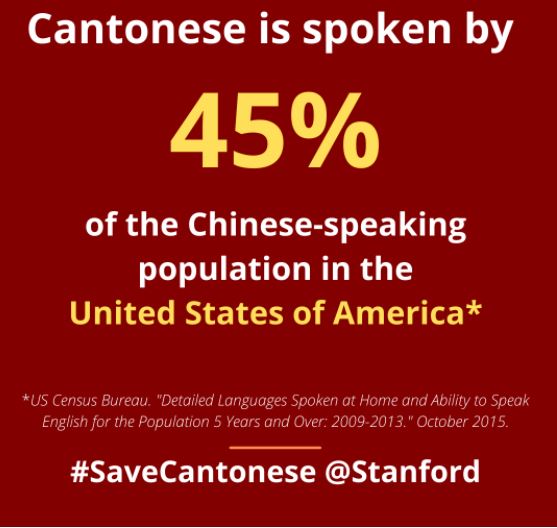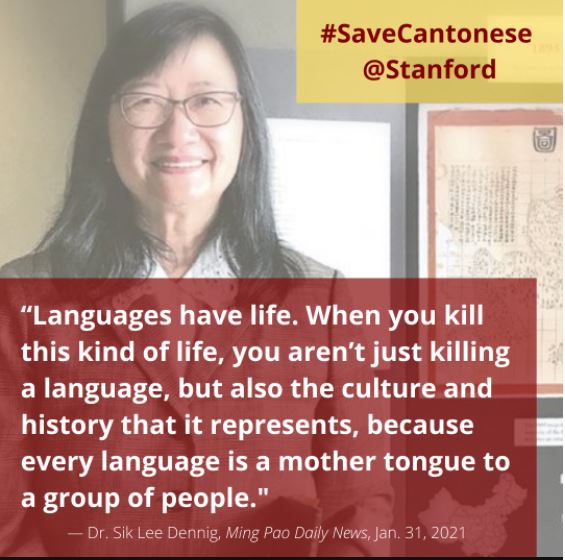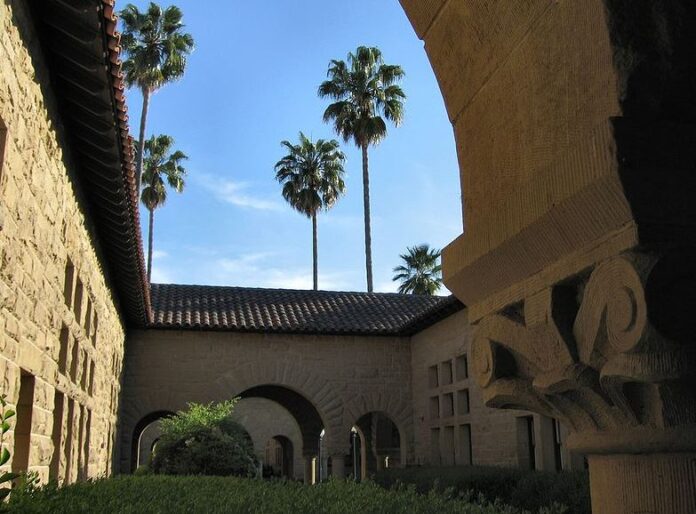By Erin Chew, AsAmNews Staff Writer
One of the last universities in the United States to teach Cantonese is cutting the program’s only full time position, a move many fear will put the classes in jeopardy.
Stanford University informed Dr. Sik Lee Dennig her position would be eliminated effective in August. Dennig has lead the program for two decades.
Inside Higher Ed reports figures from the Modern Language Association in 2016 indicated just 267 students were enrolled in Cantonese language classes nationwide.
Students, academics and community leaders are pushing back with the creation of the “Save Cantonese at Stanford” coalition.
Coalition leads Jamie Tam and Stephanie Tran told AsAmNews that it is extremely important to save the program, for both its historical and cultural significance.

“Cantonese is essential to understanding the history of not just San Francisco and the Bay Area, but also California and US history,” said Tran. “Historically, most immigrants who came to this country from China in the 19th century migrated from the Guangdong (Canton) region. For example, the Chinese railroad workers who built the Central Pacific half of the Transcontinental Railroad came from here.”
Stanford is named after Leland Stanford, one of four men credited with leading the effort to build the western leg of the Transcontinental Railroad
The program cut comes during a climate of rising anti-Asian hate/sentiments.
“Given ongoing racist and violent attacks against the Asian community, every organization — including Stanford — needs to think long and hard about how they are investing in API communities, said Tam.
A petition on the “Save Cantonese At Stanford” website has amassed over 3,900 signatures urging Stanford to commit to four Cantonese classes taught by a full-time benefits-eligible lecturer, and to allow Cantonese to fulfill the language requirement, which would further boost student enrollment. However, the University only plans to offer two courses taught by a part-time temporary hourly wage instructor who would not be eligible for benefits. This threatens the long-term viability of the Cantonese program.
The university located just south of San Francisco, says the cuts are needed for budgetary reasons, despite having an endowment valued at 30.3 billion as of August 31.
Joy Leighton, a spokeswoman for Stanford’s School of Humanities and Sciences, defended the cuts to Inside Higher Ed.
“Like many departments, the Language Center is managing a budget shortfall, which included not filling positions due to retirements, open positions, and in some cases, not renewing lecturer contracts,” said Joy Leighton, spokeswoman for Stanford’s School of Humanities and Sciences.
“Almost all languages had some reduction in course offerings.”
Leighton says anyone whose contract will not be renewed has been given plenty of notice so they could search for other jobs, if needed.

According to the coalition, their efforts are supported by 373 educators and researchers in Asian or Asian American Studies, and 589 professionals working at Asian or Asian American organizations.
The petition also included signatures from eight direct descendants of Chinese railroad workers.
The Coalition is calling for the creation of an endowed lecturer position for Cantonese language education.
“An endowed teaching position would protect the program from future budget cuts and allow Cantonese to be permanently part of Stanford’s educational mission. Future generations of students would have access to Cantonese courses and be able to reach proficiency in the language,” the coalition said.
Coalition members also include Tao Large, Kevin Hsu, Shawn Lee, Brian Chan, and Maciej Kurzynski.
More information about the “Save Cantonese At Stanford” coalition can be found on their website.
AsAmNews has Asian America in its heart. We’re an all-volunteer effort of dedicated staff and interns. Check out our new Instagram account. Go to our Twitter feed and Facebook page for more content. Please consider interning, joining our staff, or making a financial contribution to support us.




